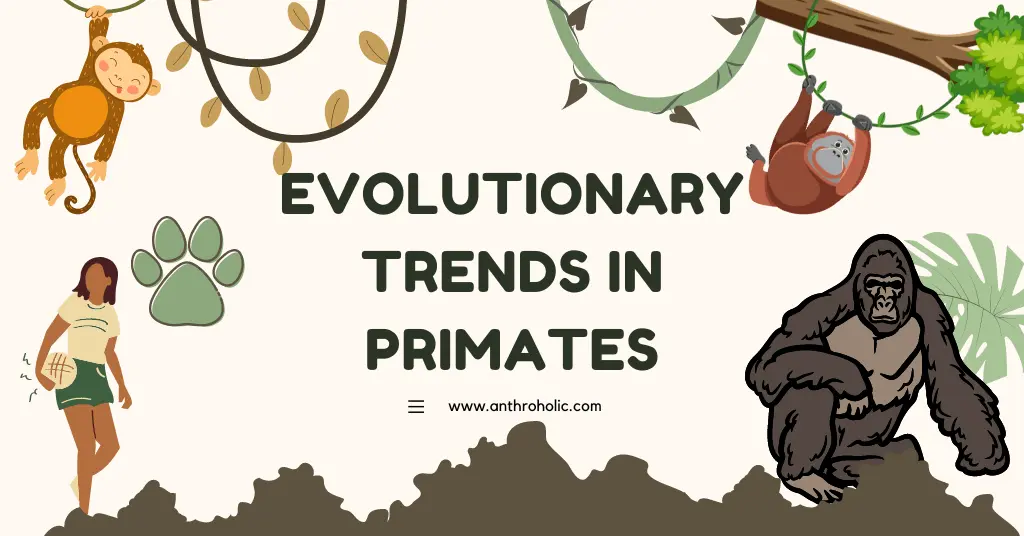AI Answer Evaluation Platform Live Now. Try Free Answer Evaluation Now
Evolutionary Trends in Primates
The study of evolution provides a fascinating insight into the history of life on Earth. Within this vast tapestry of evolution, the story of primates stands out for its complexity and significance to our understanding of human development. This anthropological article explores the evolutionary trends in primates, focusing on their remarkable adaptive strategies and the diverse array of species that have emerged over millions of years. By delving into the anatomical, behavioral, and ecological aspects of primate evolution, we gain valuable insights into our own evolutionary heritage and the factors that have shaped the primate order as a whole.

Early Primate Ancestors
Primates’ origin dates back to the Paleocene epoch, roughly 66 million years ago, where the first primate-like mammals, or ‘Plesiadapiforms‘, were believed to have lived [1]. Although they did not possess key primate features, these early ancestors paved the way for the evolution of true primates.
Emergence of True Primates
True primates, also known as ‘Euprimates‘, appeared in the Eocene epoch (about 56 to 33.9 million years ago). The fossils of two key Euprimate groups, Adapids and Omomyids, demonstrate characteristics such as forward-facing eyes and grasping hands, which are distinct primate features [2].
Anatomical Adaptations
- One significant evolutionary trend in primates involves their anatomical adaptations, which are closely linked to their arboreal habitat and complex social behaviors.
- Grasping hands and feet with opposable thumbs and toes allow primates to navigate trees with agility and precision.
- This adaptation enabled early primates to exploit the resources available in the forest canopy, providing an evolutionary advantage.
- Additionally, forward-facing eyes with stereoscopic vision granted primates enhanced depth perception, essential for accurately judging distances while leaping between branches.
- The development of color vision further facilitated the detection of ripe fruits and the recognition of subtle social cues.
Behavioral Complexity
- Primates exhibit intricate social behaviors, which have evolved over time and contributed to their survival and reproductive success.
- Social structures, ranging from solitary to highly social, have emerged among different primate species.
- The cooperative care of offspring, complex grooming rituals, and the establishment of dominance hierarchies are common behavioral traits observed in primates.
- Such behaviors not only promote group cohesion but also facilitate the acquisition and transmission of knowledge, offering advantages for survival and adaptation.
Ecological Niche Specialization
- Primates have diversified into a wide range of ecological niches, adapting to various environments and food sources.
- This diversification has led to the emergence of distinct primate groups, including prosimians, New World monkeys, Old World monkeys, and hominoids.
- Prosimians, such as lemurs and tarsiers, often occupy nocturnal niches and exhibit unique adaptations for night vision.
- New World monkeys have evolved prehensile tails, enabling them to grasp branches and navigate their arboreal habitats effectively.
- Old World monkeys, on the other hand, have adapted to various habitats, including forests and grasslands.
- Finally, hominoids, including great apes and humans, demonstrate diverse ecological adaptations while exhibiting greater flexibility in terms of habitat and diet.
Evolutionary Relationships
- Studying the evolutionary relationships among primate species allows us to reconstruct the branching patterns and understand the connections between different lineages.
- Molecular biology techniques, such as DNA analysis, have played a vital role in uncovering the intricate relationships among primates.
- The shared genetic heritage between humans and other primates sheds light on our common ancestry and the evolutionary processes that have shaped our species.
- Comparative studies of primate genomes have also revealed insights into genetic adaptations, such as immune system function and cognitive abilities.
Emergence of Hominids
Bipedalism: A Key Shift
The development of bipedalism — walking on two feet — was a monumental shift in the primate lineage leading to hominids, the group including humans and our closest extinct ancestors [3].
The Genus Homo and Human Evolution
The emergence of the genus Homo around 2.5 million years ago marked a significant evolutionary development. Traits like increasing brain size, use of tools, and development of complex social structures are central to the Homo lineage, culminating in Homo sapiens, modern humans [4].
Conclusion
The evolutionary trends in primates reflect their remarkable adaptability, complex social behaviors, ecological niche specialization, and genetic relationships. Understanding the evolutionary history of primates not only provides insights into our own species but also highlights the importance of conserving primate diversity and their natural habitats. As we continue to explore and uncover the mysteries of primate evolution, we gain a deeper appreciation for the intricate web of life that encompasses our planet’s rich biological heritage.
References
[1] Rose, K. D. (2006). The Beginning of the Age of Mammals. Johns Hopkins University Press.
[2] Seiffert, E. R. (2007). A new estimate of afrotherian phylogeny based on simultaneous analysis of genomic, morphological, and fossil evidence. BMC Evolutionary Biology, 7(1), 224. https://www.researchgate.net/publication/5846720_A_new_estimate_of_afrotherian_phylogeny_based_on_simultaneous_analysis_of_genomic_morphological_and_fossil_evidence
[3] Lovejoy, C. O. (1981). The origin of man. Science, 211(4480), 341-350.
[4] Antón, S. C. (2012). Early Homo: Who, When, and Where. Current Anthropology, 53(S6), S278-S298.




